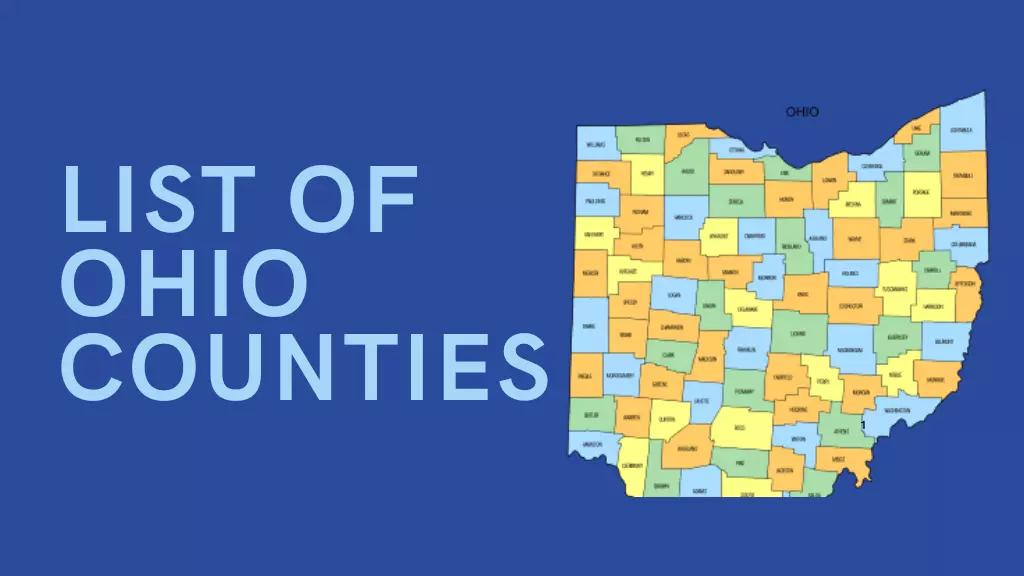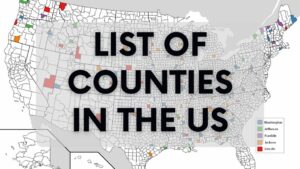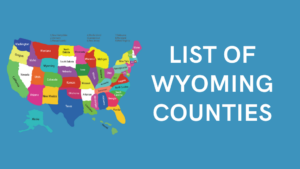The list of Ohio counties provides a detailed look at the 88 counties that shape the state’s geography, culture, and history. Each county has its own story, from early settlements and historic landmarks to modern communities that thrive in education, business, and industry. Ohio’s counties include both bustling urban centers like Franklin and Cuyahoga, as well as peaceful rural areas that showcase natural beauty and tradition. Together, these counties form the foundation of Ohio’s government, economy, and lifestyle. Exploring this complete list helps readers better understand the diversity and importance of every county in Ohio.
List of Counties in Ohio
Ohio, often called the “Buckeye State,” is a fascinating mix of cultures, landscapes, and communities. From busy cities to quiet countryside, every part of the state carries a unique identity.
Adams County (1797)
Adams County, established in 1797, is one of Ohio’s oldest counties. Named after President John Adams, it lies in the southern region and is known for its rolling Appalachian foothills and the Ohio River, which provides scenic views and outdoor recreation.
Allen County (1820)
Formed in 1820, Allen County is located in northwestern Ohio. Its county seat, Lima, is an industrial hub with strong ties to automotive and oil refining industries.
Ashland County (1846)
Ashland County, created in 1846, is recognized for its rural charm and agricultural economy. Farms producing corn, soybeans, and livestock shape its community, while the annual county fair highlights local culture.
Ashtabula County (1808)
Ashtabula County, founded in 1808, borders Lake Erie in northeastern Ohio. Its name means “river of many fish,” reflecting its history as a center for fishing and water-related activities.
Athens County (1805)
Established in 1805, Athens County is home to Ohio University. Its status as a college town gives the region a lively cultural and academic atmosphere.
Auglaize County (1848)
Auglaize County, formed in 1848, is named after the Auglaize River. Located in western Ohio, it is known for its agricultural heritage and scenic rural landscapes.
Belmont County (1801)
Created in 1801, Belmont County in eastern Ohio has historic significance tied to coal mining. Its county seat, St. Clairsville, features preserved historic buildings and museums.
Brown County (1818)
Established in 1818, Brown County is located in southwestern Ohio. Its rural countryside, small-town charm, and historic Georgetown define its character.
Butler County (1803)
Butler County, founded in 1803, blends urban and rural communities. Hamilton serves as the urban center, while Oxford is home to Miami University, adding cultural vibrancy.
Carroll County (1833)
Carroll County, created in 1833 in eastern Ohio, is valued for its quiet rural landscapes and agriculture. Corn and soybean farming are central to the local economy.
Champaign County (1805)
Formed in 1805, Champaign County in western Ohio combines rural beauty with urban development. Urbana, its county seat, is known for history and culture.
Clark County (1818)
Clark County, established in 1818, is anchored by Springfield, a major urban center. Its economy benefits from manufacturing, healthcare, and education.
Clermont County (1800)
Founded in 1800, Clermont County in southwestern Ohio offers both suburban and rural appeal. Batavia, the county seat, adds historical significance.
Clinton County (1810)
Clinton County, created in 1810, has a strong agricultural base with farms producing corn and soybeans. Its landscapes and small communities highlight Ohio’s rural charm.
Columbiana County (1803)
Established in 1803, Columbiana County in eastern Ohio is a mix of rural beauty and industry. Named after Christopher Columbus, it combines agriculture, tourism, and manufacturing.
Coshocton County (1810)
Coshocton County, formed in 1810, is known for rolling hills, forests, and historic attractions like Roscoe Village and the Three Rivers Wine Trail.
Crawford County (1820)
Created in 1820, Crawford County is recognized for small towns, farmland, and scenic countryside. Agriculture is the backbone of its economy.
Cuyahoga County (1807)
Cuyahoga County, founded in 1807, is Ohio’s most populous county. Its seat, Cleveland, is a cultural and industrial hub, while the Cuyahoga River inspired its name.
Darke County (1809)
Formed in 1809, Darke County in western Ohio thrives on agriculture. Corn, wheat, and soybeans are central to its farming tradition.
Defiance County (1845)
Defiance County, established in 1845, was named after Fort Defiance, an important military stronghold during the late 18th century. Over time, the county has developed a strong agricultural base while also preserving its historical roots.
Delaware County (1808)
Established in 1808 in central Ohio, Delaware County is known for its rapid growth and suburban communities. Its county seat, Delaware, supports a diverse economy of agriculture, manufacturing, education, and healthcare.
Erie County (1838)
Founded in 1838, Erie County borders Lake Erie and is popular for boating, fishing, and tourism. Sandusky, its county seat, is home to Cedar Point amusement park.
Fairfield County (1800)
Fairfield County, created in 1800, is located in central Ohio. Lancaster, the county seat, is recognized for its historic architecture and cultural heritage.
Fayette County (1810)
Established in 1810, Fayette County in southwestern Ohio blends rural charm with history. Washington Court House serves as its county seat.
Franklin County (1803)
Franklin County, created in 1803, is Ohio’s most populous county and home to Columbus, the state capital. The county is recognized for its strong and diverse economy, which thrives on sectors such as technology, education, healthcare, government, and finance
Fulton County (1850)
Founded in 1850, Fulton County in northwestern Ohio is noted for its farmlands and crops such as soybeans and corn.
Gallia County (1803)
Established in 1803, Gallia County in southern Ohio borders the Ohio River. Gallipolis, the county seat, reflects local heritage, while farming remains central to the economy.
Geauga County (1806)
Geauga County, founded in 1806, is known for its Amish communities, farmers’ markets, and natural countryside in northeastern Ohio.
Greene County (1803)
Established in 1803, Greene County is located in southwestern Ohio. Its county seat, Xenia, preserves historic architecture.
Guernsey County (1810)
Created in 1810 in eastern Ohio, Guernsey County is valued for its rolling hills and heritage sites. Cambridge, the county seat, highlights local history.
Hamilton County (1790)
Founded in 1790, Hamilton County is among Ohio’s most populous. Cincinnati, the county seat, anchors the region with cultural and economic vitality.
Hancock County (1820)
Hancock County, established in 1820, features rich farmlands and a community spirit. Findlay, the county seat, strengthens its economic role.
Hardin County (1820)
Founded in 1820, Hardin County in north-central Ohio is known for peaceful rural landscapes and agriculture.
Harrison County (1813)
Created in 1813, Harrison County in eastern Ohio is recognized for its rolling hills and rural charm.
Henry County (1820)
Henry County, founded in 1820, offers strong agricultural traditions, particularly soybeans and corn, and a close-knit community.
Highland County (1805)
Established in 1805 in southern Ohio, Highland County combines scenic hills, fertile farmland, and the historic town of Hillsboro.
Hocking County (1818)
Hocking County, founded in 1818, is famous for the Hocking Hills, with waterfalls, caves, and hiking trails that attract visitors.
Holmes County (1824)
Holmes County, created in 1824, is home to Amish communities and picturesque farmlands in northeastern Ohio.
Huron County (1809)
Founded in 1809, Huron County in north-central Ohio is recognized for its farmland, scenic countryside, and agricultural contributions.
Jackson County (1816)
Jackson County, created in 1816 in southeastern Ohio, features lush forests, Jackson Lake, and Shawnee State Park.
Jefferson County (1797)
Established in 1797, Jefferson County in eastern Ohio has a rich heritage. Its county seat, Steubenville, reflects both industrial and cultural history.
Knox County (1808)
Founded in 1808, Knox County in central Ohio offers rural and suburban living. Mount Vernon, the county seat, highlights preserved architecture.
Lake County (1840)
Created in 1840, Lake County borders Lake Erie, offering scenic shoreline views and water recreation.
Lawrence County (1815)
Founded in 1815, Lawrence County in southern Ohio blends fertile farmland, rolling hills, and access to the Ohio River.
Licking County (1808)
Licking County, created in 1808, is known for its agriculture and Newark, a county seat with historical significance.
Logan County (1817)
Established in 1817, Logan County in west-central Ohio thrives on corn and soybean farming.
Lorain County (1824)
Lorain County, founded in 1824, combines urban industries with Lake Erie’s shoreline beauty. Elyria serves as the county seat.
Lucas County (1835)
Lucas County, created in 1835, is home to Toledo, a major city in northwestern Ohio known for industry, commerce, and education.
Madison County (1810)
Founded in 1810, Madison County in central Ohio reflects rural charm with farmlands and small communities.
Mahoning County (1846)
Mahoning County, established in 1846, highlights Ohio’s industrial heritage. Youngstown, its county seat, remains historically significant.
Marion County (1820)
Created in 1820, Marion County in north-central Ohio is known for agriculture and a strong sense of community.
Medina County (1812)
Medina County, founded in 1812, blends suburban and rural lifestyles. Its county seat, Medina, adds cultural depth with historic architecture.
Meigs County (1819)
Established in 1819, Meigs County in southeastern Ohio features the Ohio River, hills, and forests for outdoor recreation.
Mercer County (1820)
Mercer County, created in 1820, is rooted in agriculture, particularly corn and soybean farming, with a peaceful rural atmosphere.
Miami County (1807)
Founded in 1807, Miami County in western Ohio is noted for its farmland and historic county seat, Troy.
Monroe County (1813)
Monroe County, created in 1813 in southeastern Ohio, offers forests, hills, and the Ohio River for outdoor activities.
Montgomery County (1803)
Located in southwestern Ohio, Montgomery County was established in 1803 and is known for its urban centers and cultural depth. Dayton, the county seat, is famous as the birthplace of aviation and offers rich history along with modern recreational opportunities. The county’s diverse economy includes manufacturing, commerce, education, and healthcare.
Morgan County (1817)
Founded in 1817, Morgan County lies in southeastern Ohio and is valued for its scenic hills, forests, and the Muskingum River. Outdoor activities like hiking, fishing, and boating add to its charm, while its close-knit communities provide a welcoming environment.
Morrow County (1848)
Morrow County, established in 1848, reflects Ohio’s rural traditions. Its farmlands and open spaces highlight its agricultural identity, while residents enjoy the peaceful and community-focused lifestyle.
Muskingum County (1804)
Created in 1804, Muskingum County is located in eastern Ohio and is shaped by its agricultural base. With the Muskingum River, rolling hills, and fertile farmlands, the county continues to thrive on corn and soybean farming.
Noble County (1851)
Noble County, formed in 1851, is the least populated county in Ohio but is admired for its serene hills, forests, and community spirit. Its tranquil setting reflects the quieter side of the List of Ohio Counties.
Ottawa County (1840)
Ottawa County, founded in 1840, stretches along Lake Erie and is known for its shoreline beauty. Tourism drives much of the local economy, with Port Clinton serving as a hub for recreation, fishing, and boating.
Paulding County (1820)
Established in 1820 in northwestern Ohio, Paulding County is marked by farmland and rural charm. Agriculture remains central to its economy and way of life.
Perry County (1817)
Perry County, founded in 1817, lies in southeastern Ohio. The Muskingum River and surrounding hills create opportunities for outdoor recreation and highlight the county’s natural appeal.
Pickaway County (1810)
Pickaway County was created in 1810 and is rooted in agriculture and rural living. Its seat, Circleville, adds historic and cultural value to the region.
Pike County (1815)
Pike County, established in 1815, is shaped by rolling hills, the Scioto River, and fertile farmland. Farming, especially corn and soybeans, forms the backbone of its economy.
Portage County (1807)
Founded in 1807 in northeastern Ohio, Portage County balances agriculture with growing suburban communities. Its economy is supported by farming, commerce, and manufacturing.
Preble County (1808)
Preble County, created in 1808, reflects rural Ohio life through farmland and small communities. Corn and soybean farming play a central role in its economy.
Putnam County (1820)
Established in 1820, Putnam County is characterized by farmlands and open landscapes. Agriculture remains vital to its community and culture.
Richland County (1808)
Richland County, formed in 1808, blends rural charm with history. Its seat, Mansfield, preserves cultural landmarks and architecture, giving the area added significance.
Ross County (1798)
Ross County, founded in 1798, is one of Ohio’s oldest counties. With the Scioto River, forests, and hills, it offers both natural beauty and historical depth.
Sandusky County (1820)
Sandusky County, created in 1820, is centered on agriculture and open rural spaces. Its peaceful setting makes it appealing to those who enjoy countryside living.
Scioto County (1803)
Scioto County, founded in 1803, is located along the Ohio River. Its economy relies on farming while its riverside landscapes attract outdoor enthusiasts.
Seneca County (1820)
Seneca County, established in 1820, is recognized for farmlands and strong agricultural traditions. Small communities highlight its rural identity.
Shelby County (1819)
Shelby County, created in 1819, offers fertile farmlands, rolling hills, and a community-oriented lifestyle rooted in agriculture.
Stark County (1808)
Stark County, founded in 1808, is located in northeastern Ohio. Its county seat, Canton, provides historical and cultural attractions, while farming and urban industries support its economy.
Summit County (1840)
Summit County, established in 1840, is known for its economic diversity and cultural centers. Akron, the county seat, plays a major role in education, manufacturing, and recreation.
Trumbull County (1800)
Trumbull County, created in 1800, features forests, the Mahoning River, and rolling hills. Its mix of history and natural beauty defines the county.
Tuscarawas County (1808)
Founded in 1808, Tuscarawas County is celebrated for its farmland, the Tuscarawas River, and outdoor opportunities. Agriculture remains essential to its economy.
Union County (1820)
Union County, formed in 1820, highlights farming traditions and quiet rural landscapes that reflect Ohio’s countryside character.
Van Wert County (1820)
Van Wert County, created in 1820 in northwestern Ohio, is noted for its agricultural base and welcoming rural communities.
Vinton County (1850)
Vinton County, founded in 1850, is known for Zaleski State Forest and outdoor opportunities such as hiking and hunting. Its natural beauty attracts visitors year-round.
Warren County (1803)
Warren County, created in 1803, blends rural charm with growing urban centers. Lebanon, the county seat, adds historic and cultural depth.
Washington County (1788)
Established in 1788, Washington County is Ohio’s oldest. It offers riverside beauty, rolling hills, and a heritage rooted in history.
Wayne County (1808)
Wayne County, founded in 1808, is home to the city of Wooster and combines farming traditions with suburban amenities.
Williams County (1820)
Williams County, created in 1820, reflects strong farming traditions and small-town living. Agriculture continues to be the backbone of its economy.
Wood County (1820)
Wood County, established in 1820, features a mix of farmland and the urban character of Bowling Green, its county seat, which serves as a cultural hub.
Wyandot County (1845)
Wyandot County, founded in 1845, offers rolling farmlands and a peaceful countryside environment, appealing to those who value rural life.
Conclusion
Together, Ohio’s 88 counties form a diverse picture of history, culture, and community that reflects the true spirit of the Buckeye State. Each county adds something unique, from historic landmarks and thriving industries to small-town traditions and scenic landscapes. This comprehensive list of Ohio counties highlights the balance of urban development, agriculture, and natural beauty spread across the state. Whether it’s the bustling cities that drive economic growth or the rural areas that preserve Ohio’s heritage, every county plays an important role in shaping the state’s identity and future.
FAQs
How many counties are there in Ohio?
There are 88 counties in Ohio.
Which is the largest county in Ohio?
Franklin County is the largest.
What is the smallest county in Ohio by population?
Noble County has the smallest population.
To get more guidance, visit Copy Paste Quickly.





